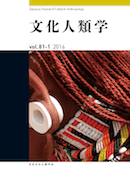82 巻, 4 号
選択された号の論文の32件中1~32を表示しています
- |<
- <
- 1
- >
- >|
表紙等
-
2018 年 82 巻 4 号 p. f1-
発行日: 2018年
公開日: 2018/10/18
PDF形式でダウンロード (691K) -
2018 年 82 巻 4 号 p. f2-
発行日: 2018年
公開日: 2018/10/18
PDF形式でダウンロード (1621K) -
2018 年 82 巻 4 号 p. 421-422
発行日: 2018年
公開日: 2018/10/18
PDF形式でダウンロード (128K) -
2018 年 82 巻 4 号 p. 423-
発行日: 2018年
公開日: 2018/10/18
PDF形式でダウンロード (1056K) -
2018 年 82 巻 4 号 p. 424
発行日: 2018年
公開日: 2018/10/18
PDF形式でダウンロード (1056K)
第12回日本文化人類学会賞受賞記念論文
-
2018 年 82 巻 4 号 p. 425-445
発行日: 2018年
公開日: 2018/10/18
PDF形式でダウンロード (1532K)
論文
-
2018 年 82 巻 4 号 p. 446-463
発行日: 2018年
公開日: 2018/10/18
PDF形式でダウンロード (1536K) -
2018 年 82 巻 4 号 p. 464-481
発行日: 2018年
公開日: 2018/10/18
PDF形式でダウンロード (1460K)
特集 在来の紛争処理をめぐる比較民族誌――「平和への創発的ポテンシャル」を探究する
-
2018 年 82 巻 4 号 p. 482-487
発行日: 2018年
公開日: 2018/10/18
PDF形式でダウンロード (1247K) -
2018 年 82 巻 4 号 p. 488-508
発行日: 2018年
公開日: 2018/10/18
PDF形式でダウンロード (1669K) -
2018 年 82 巻 4 号 p. 509-525
発行日: 2018年
公開日: 2018/10/18
PDF形式でダウンロード (1430K) -
2018 年 82 巻 4 号 p. 526-546
発行日: 2018年
公開日: 2018/10/18
PDF形式でダウンロード (1418K)
研究ノート
-
2018 年 82 巻 4 号 p. 547-556
発行日: 2018年
公開日: 2018/10/18
PDF形式でダウンロード (1285K) -
2018 年 82 巻 4 号 p. 557-566
発行日: 2018年
公開日: 2018/10/18
PDF形式でダウンロード (1276K)
資料と通信
-
2018 年 82 巻 4 号 p. 567-568
発行日: 2018年
公開日: 2018/10/18
PDF形式でダウンロード (1068K) -
2018 年 82 巻 4 号 p. 569-573
発行日: 2018年
公開日: 2018/10/18
PDF形式でダウンロード (1195K) -
2018 年 82 巻 4 号 p. 574-577
発行日: 2018年
公開日: 2018/10/18
PDF形式でダウンロード (1186K) -
2018 年 82 巻 4 号 p. 578-581
発行日: 2018年
公開日: 2018/10/18
PDF形式でダウンロード (1187K)
書評
-
2018 年 82 巻 4 号 p. 582-584
発行日: 2018年
公開日: 2018/10/18
PDF形式でダウンロード (984K) -
2018 年 82 巻 4 号 p. 584-587
発行日: 2018年
公開日: 2018/10/18
PDF形式でダウンロード (1092K) -
2018 年 82 巻 4 号 p. 587-590
発行日: 2018年
公開日: 2018/10/18
PDF形式でダウンロード (1093K) -
2018 年 82 巻 4 号 p. 590-592
発行日: 2018年
公開日: 2018/10/18
PDF形式でダウンロード (1081K) -
2018 年 82 巻 4 号 p. 592-595
発行日: 2018年
公開日: 2018/10/18
PDF形式でダウンロード (1096K) -
2018 年 82 巻 4 号 p. 595-598
発行日: 2018年
公開日: 2018/10/18
PDF形式でダウンロード (1093K)
学会通信等
-
2018 年 82 巻 4 号 p. 599-603
発行日: 2018年
公開日: 2018/10/18
PDF形式でダウンロード (1003K) -
2018 年 82 巻 4 号 p. 604-605
発行日: 2018年
公開日: 2018/10/18
PDF形式でダウンロード (896K) -
2018 年 82 巻 4 号 p. 606-
発行日: 2018年
公開日: 2018/10/18
PDF形式でダウンロード (932K) -
2018 年 82 巻 4 号 p. 607-
発行日: 2018年
公開日: 2018/10/18
PDF形式でダウンロード (954K)
裏表紙等
-
2018 年 82 巻 4 号 p. i-iv
発行日: 2018年
公開日: 2018/10/18
PDF形式でダウンロード (1012K) -
2018 年 82 巻 4 号 p. v-vi
発行日: 2018年
公開日: 2018/10/18
PDF形式でダウンロード (1002K) -
2018 年 82 巻 4 号 p. b1-
発行日: 2018年
公開日: 2018/10/18
PDF形式でダウンロード (1621K) -
2018 年 82 巻 4 号 p. b2-
発行日: 2018年
公開日: 2018/10/18
PDF形式でダウンロード (454K)
- |<
- <
- 1
- >
- >|
